Abstract
Particle size (30 to 10,000 nm) distributions in number concentration were measured using an Electrical Low Pressure Impactor onboard a Mobile Real-time Air Monitoring Platform from June 2002 to August 2003 in Hong Kong to investigate the size distributions of on-road vehicular particles and their relationship with ambient temperature (T) and relative humidity (RH). In this article, we focus on the size distributions of particles > 30 nm in vehicle plumes where fresh vehicular particles dominated and the NOx concentration was > 400 ppb. A uni-modal size distribution with mode at either 60–108 nm or 108–170 nm was generally observed from April to October. This mode is conventionally believed to be soot particles in the literature and the different mode sizes probably depend on engine and vehicle operating conditions. From November to March, a bi-modal size distribution with a dominant mode at 30–60 nm and a minor mode at either 108–170 nm or 60–108 nm was generally observed. The existence of the 30–60 nm mode is explained in the literature by the growth of nucleated particles when vehicular exhaust cools in ambient air. Ratios of the number concentration of 30–60 nm particles to BC mass concentration correlated negatively with T, as well as with RH when RH was < 60%. The ratios appeared not to be sensitive to RH when RH was > 60%. The correlations suggested that T and RH exert significant influences on the formation of vehicular submicron particles, leading to varying size distributions of vehicular particles in Hong Kong.
1. INTRODUCTION
There are many studies on vehicular particles in the literature based on short-term measurements (CitationBukowiecki et al. 2002; CitationMolnár et al. 2002; CitationZhu et al. 2002; CitationKittelson et al. 2004; CitationYao et al. 2005) and the focus is usually on emission factors of vehicular particles, transformation of dispersed particles and/or the influence of engines and vehicle operating conditions on particle concentration and particle size distribution. Vehicular particles in the Aitken mode(s) at 15–20 nm and/or 30–50 nm, and/or an accumulation mode at ∼ 100 nm have been reported in the literature using Scanning Mobility Particle Sizer (SMPS) (CitationZhu et al. 2002; CitationGidhagen et al. 2003; CitationLehmann et al. 2003; CitationKittelson et al. 2004). The Aitken modes are explained to be the growth of nucleated particles via gas condensation and particle-particle coagulation and the accumulation mode is mainly soot particles consisting mostly black carbon (BC) and organics (CitationGoldberg 1985; CitationKittelson et al. 2002; CitationMolnár et al. 2002). The growth of nucleated particles is not important in the formation of accumulation mode particles (CitationKim et al. 2002; CitationKittelson et al. 2002; CitationHarris and Maricq 2001; CitationGidhagen et al. 2003; CitationKittelson et al. 2004). A review of the literature on submicron particles emitted from vehicles readily raises the following questions:
-
Nucleation processes strongly depend on ambient temperature (T) and relative humidity (RH) (CitationVehkamäki et al. 2002; CitationKulmala et al. 2004). CitationKittelson et al. (2002) and CitationBukowiecki et al. (2003) reported that low T promotes the nucleation formation of vehicular particles. The exhaust cools down rapidly once it leaves the tailpipe and eventually equilibrates to ambient temperature. Would T and RH influence the particle number concentration and size distributions of on-road vehicular particles?
-
How to isolate the influence of T on on-road vehicular particle concentration from that of RH? Several groups have developed mobile laboratories for real-time measurements to characterize gas and particulate pollutants in the atmosphere (CitationBukowiecki, et al. 2002; CitationSeakins et al. 2002; CitationVogt et al. 2003; CitationKittelson et al. 2004; CitationKolb et al. 2004; CitationJiang et al. 2005). Mobile measurements provide “continuous snapshots” of the air quality. When driving on roads, the mobile laboratory measured air pollutants emitted by vehicles mainly in front of the mobile laboratory and/or those in opposite lanes and the background. We designed and built an air pollutant measuring vehicle called Mobile Real-time Air Monitoring Platform (MAP) which can obtain particle size distribution data (30 to 10,000 nm) as it travels on road. These data are different from those measured by stations at the sidewalks because they are the more concentrated vehicle emitted particles. The dataset obtained from June 2002 to August 2003 by MAP represents a total of 126 sets (days) of particle size distribution data. The long-term on-road particle size distribution data collected under a broad range of T and RH are examined. In this article, we focus on particles in the 30–260 nm range since particles > 260 nm contribute only in a minor way to the total particle number concentration. Number concentration is used in this article unless otherwise specified.
2. EXPERIMENTAL
The following instruments are onboard MAP: an Electrical Low Pressure Impactor (ELPI) (Dekati, Ltd.); stand-alone gas analyzers for SO2, NOx, CO, and O3 (API, Inc.); an aethalometer (Magee Scientific) to measure black carbon (BC); an automatic weather station; a global positioning system (GPS) for navigation. The BC measured is the BC concentration in total particles. Five routes, varying from 50 to100 km in length, are used for measurements. shows the route used by ∼ 50% of the total 126 sets (days) of measurements, covering urban, rural, mountainous and some difficult to access areas, e.g., covered public garages and tunnels. In each run, MAP measured air pollutants nominally from 10:00 to 16:00. Each measurement started and ended at the campus of HKUST, and MAP usually took an anti-clockwise direction (north–west–south–east–north) on the route. Traffic conditions included low traffic country roads, highways with high volume of heavy-duty trucks, city streets, and tunnels. For specific study areas, multiple loops (cruises) would be made.
FIG. 1 PM2.5 track on 25 July 2002 (city streets, tunnels, and heavily traveled heavy-duty highways are in broken circles; *highways passing through urban areas and considered to be urban streets).
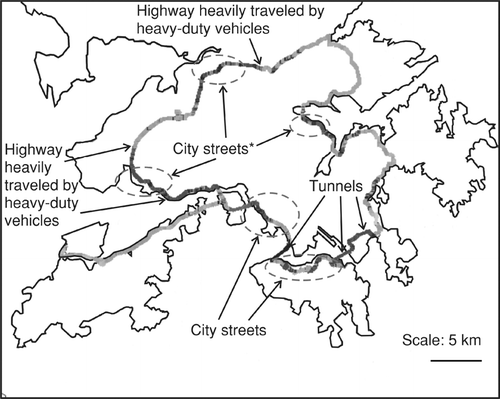
ELPI has been evaluated against SMPS measurements for performance and good agreement was obtained for particle size (CitationKeskinen et al. 1992; CitationMaricq et al. 2000; CitationMarjamäki et al. 2000). However, ELPI contains only six cut-off diameters for submicron particles (i.e., 30–60, 60–108, 108–260, 260–400, 400–650, and 650–1000 nm). Aerodynamic diameter is used in ELPI while mobility diameter is used in SMPS. One Atiken mode could occur at the particle size < 30 nm and it is important in differentiating gasoline vehicular exhaust plumes from diesel vehicles (Zhu et al. 2002a; CitationGidhagen et al. 2003; CitationLehmann et al. 2003; CitationKittelson et al. 2004;CitationYao et al. 2005), however, they are outside of the measurement range of ELPI. Thus, we restrict our discussion to the particles > 30 nm detectable by ELPI.
The general measurement strategies used by mobile laboratories are well described by CitationKolb et al. (2004) and CitationJiang et al. (2005). In addition, CitationJiang et al. (2005) proposed that the mobile data could be analyzed using microscopic (for an individual vehicle) and macroscopic (for a larger number of vehicles) approaches. We adopted the latter approach to study the behavior of particles emitted from on-road vehicular fleets.
3. RESULTS AND DISCUSSION
3.1. Characteristics of Particle Size Distribution in Vehicle Plumes
NOx is used to identify vehicular plumes. SO2 is not a good indicator because Hong Kong uses low sulfur content (< 150 ppm for gasoline and < 50 ppm for diesel) automotive fuels. In Hong Kong, it has been reported that the annual averaged NOx concentrations at the background, suburban and urban sites were 7, 37, and 74 ppb, respectively (So and Wang 2003). In this study, ambient air is defined when NOx is < 50 ppb, and vehicle plume is defined when NOx is > 400 ppb. The total number concentrations of > 30 nm particles in vehicle plumes was found to be one order of magnitude higher than ambient particle concentrations. A mixture of the two is experienced when NOx is in between 50–400 ppb. On light traffic country highways, NOx is generally < 400 ppb, thus they are not the focus of this study. A summary of particle size distributions in vehicle plumes is in . Only the dominant size distribution data in each sampling period are presented. Details on how “dominant size distribution” is determined can be found in the footnotes of .
TABLE 1 Distribution of particle mode frequencies in vehicle plumes (NOx > 400 ppb) for the whole dataset
The particle size distributions in vehicle plumes can be classified into two regimes when referenced to the seasons. From November to March, a bi-modal size distribution (BM) for particles > 30 nm was generally observed and the dominant mode was at 30–60 nm. The bi-modal regime can be further divided into two groups: BM30/108, when the concentration of 108–170 nm particles was larger than that of 60–108 nm particles, and, BM30/60, when the reverse is true. The 30–60 nm mode has been reported in street, highway, and tunnel studies in the literature (CitationKim et al. 2002; CitationKittelson et al. 2002; CitationMolnár et al. 2002; CitationZhu et al. 2002; CitationGidhagen et al. 2003; CitationKittelson et al. 2004; CitationYao et al. 2005) and was conventionally attributed to the coagulation and condensation growth of the nucleated particles as mentioned earlier.
From April to October, a uni-modal size distribution (UM) was generally detected and the mode was either at 60–108 (UM60) or at 108–170 nm (UM108). These particle size distributions have also been detected in vehicle exhausts in the literature and are ascribed to soot particles (BC and condensed organics), and the formation of these particles from the growth of nucleated particles is not important (CitationMolnár et al. 2002; CitationGidhagen et al. 2003; CitationLehmann et al. 2003; CitationKittelson et al. 2004).
In all 126 sets of dataset, the particle size distributions in vehicle plumes were found to be similar all over Hong Kong in a particular day although the particle concentrations could vary significantly. This suggests that daily averaged particle size distributions in vehicle plumes could be used in the mode analysis. However, the particle size distributions in vehicle plumes could be different on different days. For example, on July 25, 2002 (daily averaged T = 32°C, RH = 71%), UM108 was detected in vehicle plumes all over Hong Kong (, , ) while BM30/60 was observed on January 6, 2003 (daily averaged T = 12°C, RH = 70%) (, , ). There was a 20°C difference in temperature between the two days and low T favors the nucleation formation of vehicle particles as proposed by CitationKittelson et al. (2002) and CitationBukowiecki et al. (2003). This raises the possibility that the 30–60 nm mode on January 6 could be related to the low T and the significantly lower T on that day suggested weaker photochemical processes. Therefore, photochemical processes are not likely to be responsible for the occurrence of the 30–60 nm mode on January 6, 2003. Likewise, similar daily averaged RH for the two days suggests that hygroscopic growth cannot explain the occurrence of the 30–60 nm mode on January 6, 2003 and the absence of the mode on July 25, 2002.
FIG. 2 Particle number size distribution on 25 July 2002 (a: minutely average concentrations; b and c: dNv/dlog Dp is the particle concentration in vehicle plumes (NOx > 400 ppb), dNa/dlog Dp is the particle concentration in ambient air (NOx < 50 ppb), averages are used; PN = dNv/dlog Dp-dNa/dlog Dp; H-hiway: highways heavily traveled by heavy-duty vehicles).
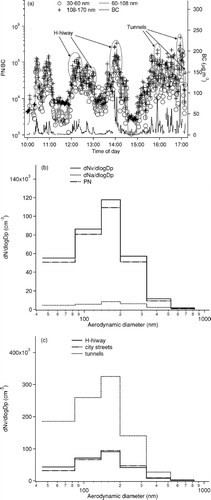
FIG. 3 Particle number size distribution on 6 January 2003 (a) minutely averages; b and c: dNv/dlog Dp is the particle concentration in vehicle plumes (NOx > 400 ppb), dNa/dlog Dp is the particle concentration in ambient air (NOx < 50 ppb), averages are used; PN = dNv/dlog Dp-dNa/dlog Dp; H-hiway: highways heavily traveled by heavy-duty vehicles; ELPI missing data due to instrument zero reset).
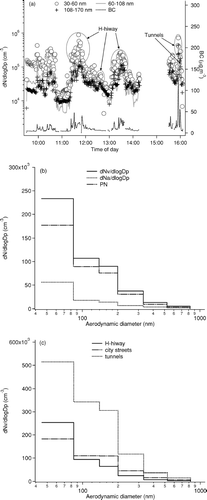
The daily averaged particle size distributions in vehicle plumes are shown in , , and , , . Subtracting the daily averaged particle concentration of ambient air from that in the vehicle plume in each size bin yields the daily averaged concentration of freshly formed vehicular particles. For data with similar daily averaged size distributions, the size distribution data were averaged again to obtain the multi-daily averaged size distributions and they are shown with the standard deviations in . Overwhelming contribution from the traffic can be seen in the particle concentrations. The average concentrations of each particle size bin in the vehicle plumes were approximately one order of magnitude higher than those in the ambient air. The same can be said for BC. The formation of particles in vehicle plumes is to be discussed below.
TABLE 2 Black carbon and submicron particle concentrations for four types of particle size distributions
3.2. Size-Segregated Particle Concentrations in Vehicle Plumes
In this section, we will focus on the formation of freshly formed vehicular particles (> 30 nm) by studying the concentrations of the 30–260 nm particles, the concentrations of each particle size bin, and the ratios of the particle number concentration to BC mass concentration (referred to as “PN/BC” hereafter). We define PN/BC as follows:
From the vehicle plume data in , BM30/60 distributions had the highest 30–260 and 30–60 nm particle concentrations and PN/BC. This suggests that, in the BM30/60 distributions, a large proportion of the particles were probably formed by the growth of nucleated particles. By the same analysis, the opposite is true for UM108 distributions.
For the overall 30–260 nm particles, highest particle concentration and PN/BC ratio were also found in the BM30/60 distribution and the lowest in UM108. Because the 108–260 nm particles were mainly soot particles, the PN/BC ratios were found to be similar in all four size distributions. Thus, the variation in the PN/BC ratio of the 30–260 nm particles was due to the growth of nucleated particles to form the 30–108 nm particles.
3.3. Influences of T and RH on Particle Formation in On-Road Plumes
In vehicle plumes, the formation of particles > 30 nm via nucleation, coagulation and condensation processes depends on T and RH and the nucleation processes are especially sensitive to these parameters (CitationWexler et al. 1994; CitationZhang and Wexler 2002; CitationVehkamäki et al. 2002). Concentrations of vehicular particles grown from nucleated particles, therefore, can be a complex function of T and RH and the relationship may not be linear (CitationSeinfeld and Pandis 1998; CitationNaparia et al. 2002; CitationVehkamäki et al. 2002). Two approaches—dynamic modeling and statistic analysis—can be used to investigate the dependence. The latter is used in this study.
As summarized in and , , PN/BC for the 30–260 and 30–60 nm particles is negatively correlated with T (r2 = 0.30 and 0.42, respectively). The one extraneous point in , is due to the rare occurrence of high T with low RH in Hong Kong. Excluding the extraneous point in , , r2 becomes 0.36 and 0.50, respectively. When RH is < 60% (, ), PN/BC is negatively correlated with RH (r2 = 0.54 and 0.55, respectively), and when RH is > 60%, PN/BC appears not to be sensitive to RH.
TABLE 3 Correlation coefficients (r2) of PN/BC with T and RH, PN/BC with 1/T and 1/RH in vehicleplumes (NOx > 400 ppb,1 all dataset,2 only when RH > 80%,3 only when T varied from 27 to 29°C,4 in tunnels, * 30–60 nm particles, ** only when RH < 60%).
FIG. 4 Correlations of PN/BC with T or RH (PN/BC is defined by Equation (Equation1) in the text and in 104× cm−3/ μ g m− 3; extraneous points (circled) are due to the fact that in Hong Kong, high T seldom occurs with low RH while low T seldom occurs with high RH).
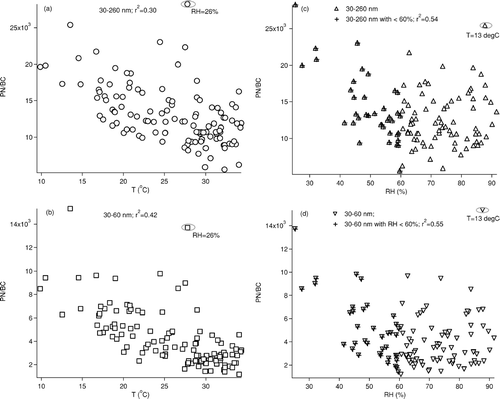
Since both T and RH can affect PN/BC, a parametric study is needed. When RH is > 80%, r2 (negative correlation) for PN/BC with T is 0.53 and 0.49, respectively for the 30–260 and 30–60 nm particles, and r2 (positive correlation) for PN/BC with 1/T is 0.53 and 0.54, respectively (, ); and when T is 27–29°C, r2 (negative correlation) for PN/BC with RH is 0.50 and 0.53, respectively, and r2 (positive correlation) for PN/BC to 1/RH improved to 0.67 and 0.73, respectively. This suggests that the formation of the > 30 nm particles may be inversely proportional to RH (, ). CitationKim et al. (2002), CitationGidhagen et al. (2003), and CitationJacobson and Seinfeld (2004) examined the size distributions of vehicular particles. In their modeling studies, the nucleation process included only the binary nucleation of sulfuric acid and water. In the presence of NH3 in ambient air and in vehicle exhaust, ternary nucleation of sulfuric acid-ammonia-water could occur. CitationNaparia et al. (2002) simulated the ternary nucleation of sulfuric acid-ammonia-water and found that the nucleation rate is proportional to 1/RH. Vehkamäki et al. (2002) reported that the nucleation rate of sulfuric acid-water increases with increasing RH. The complex dependence of PN/BC on RH could be related to the two nucleation processes.
FIG. 5 Correlation of PN/BC with T or RH under specific conditions (PN/BC is defined by Equation (Equation1) in the text and in 104× cm− 3/ μ g m− 3).
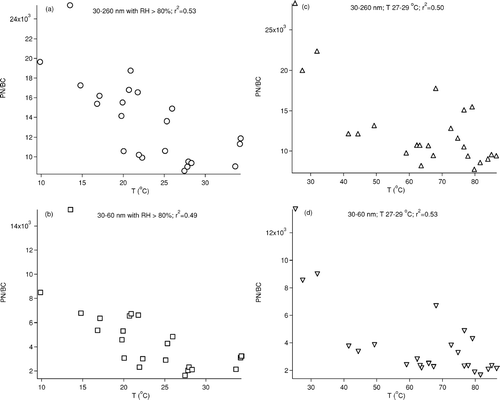
A similar analysis on the MAP tunnel data, where the pollutant concentrations are high and the main source is automobiles, would shed more light on the discussion. Data (62 sets) extracted from measurements shown in are used to correlate PN/BC with T and 1/RH. In , r2 for PN/BC (30–60 nm) with T is 0.35. When only RH < 60% data are used, r2 of PN/BC with 1/RH is 0.51. Thus, in vehicular plumes, negative correlation of PN/BC with T and positive correlation of PN/BC with 1/RH are observed.
4. CONCLUSION
The size distribution of particles > 30 nm in vehicle plumes in Hong Kong was either uni-modal (April to September) or bi-modal (November to March). A comparison of particle number concentration and PN/BC between the size distributions and correlation analysis between PN/BC and T and RH showed that the 30–60 nm mode was due to the growth of nucleated particles and was negatively correlated to T and RH. This suggests that under low T and/or low RH conditions, the cooling of vehicle plumes in ambient air probably results in the increase in the concentration of the 30–60 nm particles and the formation of 30–60 nm mode. By the same token, high T and moderate to high RH (> 60%) do not favor the formation the of 30–60 nm mode. Overall, T and RH exert significant influences on the formation of submicron particles in on-road vehicle plumes and the variation of T and RH is the most probable reason responsible for varying size distributions of vehicular particles in Hong Kong.
The financial support by the Hong Kong Jockey Club Charities Trust in the Mobile Real-time Air Monitoring Platform (MAP) project is gratefully acknowledged. We thank the MAP team, Messer. K.L. To, Win Tsang, Alex Tam, and Alta Choi, who are responsible for the real-time mobile air quality data used in this article.
Notes
*BM30/60 represents bi-modal size distributions, where the concentration of 108–170 nm particles was smaller than that of 60–108 nm particles; BM30/108 represents bi-modal size distributions, where the concentration of 108–170 nm particles was larger than that of 60–108 nm particles.
**Zero “0” is assigned to size distribution occurring at a frequency lower than the dominant size distributions in vehicle plumes in each sampling. For example, in June, the frequency of BM30/60 occurring was either less than that of UM60 or UM108 in vehicle plumes in each sampling period.
***There were two days when UM60 were the dominant size distribution in vehicle plumes. The other size distributions may or may not be detected in vehicle plumes. The frequency of occurrence of UM60 was higher than that of the other distributions in the sampling periods of these two days.
*BCa and BCv are black carbon ambient air and in vehicle plumes, respectively, concentrations in μ g m− 3;
**dNa/dlog Dp is the particle number concentration in ambient air, in ×104 cm− 3;
***dNv/dlog Dp is the particle number concentration in vehicle plumes, in × 104 cm− 3;
**** PN/BC = (dNv/dlogDp-dNa/dlogDp)/([BCv]-[BCa]) in 104× cm− 3/ μ g m− 3;
#BM30/60 represents bi-modal size distributions, where the concentration of 108–170 nm particles was smaller than that of 60–108 nm particles; BM30/108 represents bi-modal size distributions, where the concentration of 108–170 nm particles was larger than that of 60–108 nm particles;
##Average and standard deviation.
REFERENCES
- Bukowiecki , N. , Dommen , J. , Prévôt , A. S. H. , Richter , R. , Weingartner , E. and Baltensperger , U. 2002 . A Mobile Pollutant Measurement Laboratory-Measuring Gas Phase and Aerosol Ambient Concentrations with High Spatial and Temporal Resolution . Atmos. Environ. , 36 : 5569 – 5579 .
- Bukowiecki , N. , Dommen , J. , Prévôt , A. S. H. , Richter , R. , Weingartner , E. and Baltensperger , U. 2003 . Fine and Ultrafine Particles in the Zürich (Switzerland) Area Measured with a Mobile Laboratory: An Assessment of the Seasonal and Regional Through a Year . Atmos. Chem. Phys. , 3 : 1477 – 1494 .
- Gidhagen , L. , Johansson , C. , Ström , J. , Kristensson , A. , Swietlicki , E. , Pirjola , L. and Hansson , H. C. 2003 . Model Simulation of Ultrafine Particles Inside a Road Tunnel . Atmos. Environ. , 37 : 2023 – 2036 .
- Goldberg , E. D. 1985 . Black Carbon in the Environment , New York : Wiley .
- Harris , S. J. and Maricq , M. M. 2001 . Signature Size Distributions for Diesel and Gasoline Engine Exhaust Particulate Matter . J. Aerosol Sci. , 32 : 749 – 764 .
- Jacobson , M. K. and Seinfeld , J. H. 2004 . Evolution of Nanoparticle Size and Mixing State Near the Point of Emission . Atmos. Environ. , 38 : 1839 – 1850 .
- Jiang , M. , Marr , L. C. , Dunlea , E. J. , Herndon , S. C. , Jayne , J. T. , Kolb , C. E. , Knighton , W. B. , Rogers , T. M. , Zavala , M. , Molina , L. T. and Molina , M. J. 2005 . Mobile Laboratory Measurements of Black Carbon, Polycyclic Aromatic Hydrocarbons and Other Vehicle Emissions in Mexico City . Atmos. Chem. Phys., Discuss. , 5 : 7387 – 7414 .
- Keskinen , J. , Pietarinen , K. and Lehtimäki , M. 1992 . Electrical Low Pressure Impactor . J. Aerosol Sci. , 23 : 353 – 360 .
- Kim , D. , Gautam , M. and Gera , D. 2002 . Parametric Studies on the Formation of Diesel Particulate Matter Via Nucleation and Coagulation Modes . J. Aerosol Sci. , 33 : 1609 – 1621 .
- Kittelson , D. B. , Watts , W. F. and Johnson , J. P. 2002 . Diesel Aerosol Sampling Methodology -CRC-43, Technical Summary and Conclusion , Alpharetta, GA : Coordinating Research Council .
- Kittelson , D. B. , Watts , W. F. and Johnson , J. P. 2004 . Nanoparticle Emissions on Minnesota Highways . Atmos. Environ. , 38 : 9 – 19 .
- Kolb , C. E. , Herndon , S. C. , McManus , J. B. , Shorter , J. H. , Zahniser , M. S. , Nelson , D. D. , Jayne , J. T. , Canagaratna , M. R. and Worsnop , D. R. 2004 . Mobile Laboratory with Rapid Response Instruments for Real-Time Measurements of Urban and Regional Trace Gas and Particulate Distributions and Emission Source Characteristics . Environ. Sci. Technol. , 38 : 5694 – 5703 .
- Kulmala , M. , Vehkamäki , H. , Petäjä , T. , Maso , M. D. , Lauri , A. , Kerminen , V.-M , Birmili , W. and McMurry , P. H. 2004 . Formation and Growth Rates of Ultrafine Atmospheric Particles: A Review of Observations . J. Aerosol Sci. , 35 : 143 – 176 .
- Lehmann , U. , Mohr , M. , Schweizer , T. and Rütter , J. 2003 . Number Size Distribution of Particulate Emissions of Heavy-Duty Engines in Real Word Test Cycles . Atmos. Environ. , 37 : 5247 – 5259 .
- Maricq , M. M. , Podsiadlik , D. H. and Chase , R. E. 2000 . Size Distribution of Motor Vehicle Exhaust PM: A Comparison Between ELPI and SMPS Measurements . Aerosol Sci. Technol. , 33 : 239 – 260 .
- Marjamäki , M. , Keskinen , J. , Chen , D. R. and Pui , D. Y. H. 2000 . Performance Evaluation of the Electrical Low-Pressure Impactor (ELPI) . J. Aerosol Sci. , 31 : 249 – 261 .
- Molnár , P. , Janhäll , S. and Hallquist , M. 2002 . Roadside Measurements of Fine and Ultrafine Particles at a Major Road North of Gothernburg . Atmos. Environ. , 35 : 4115 – 4123 .
- Seakins , P. W. , Lansley , D. L. , Hodgson , A. , Huntley , N. and Pope , F. 2002 . Mobile Laboratory Reveals New Issues in Urban Air Quality . Atmos. Environ. , 36 : 1247 – 1248 .
- Seinfeld , J. H. and Pandis , S. N. 1998 . Atmospheric Chemistry and Physics: From Air Pollution to Climate Change , New York : John Wiley & Sons .
- Naparia , T. , Noppel , M. , Vehkamäki , H. and Kulmala , M. 2002 . An Improved Model for Ternary Nucleation of Sulfuric Acid–Ammonia–Water . J. Chem. Phys. , 116 doi:10.1063/1.1450557
- Vehkamäki , H. , Kulmala , M. , Napari , I. , Lehtinen , K. E. J. , Timmreck , C. , Noppel , M. and Laaksonen , A. 2002 . An Improved Parameterization for Sulfuric Acid-Water Nucleation Rates for Tropospheric and Stratospheric Conditions . J. Geophys. Res. , 107 : 4622 doi:10.1029/2002JD002184
- Vogt , R. , Scheer , V. , Casati , R. and Benter , T. 2003 . On-road Measurement of Particle Emission in the Exhaust Plume of a Diesel Passenger Car . Environ. Sci. Technol. , 37 : 4070 – 4076 .
- Wexler , A. S. , Lurmann , F. W. and Seinfeld , J. H. 1994 . Modeling Urban and Regional Aerosols—I. Development . Atmos. Environ. , 28 : 531 – 546 .
- Yao , X. H. , Lau , N. T. , Fang , M. and Chan , C. K. 2005 . Real-Time Observation of the Transformation of Ultrafine Atmospheric Particle Modes . Aerosol Sci. Technol. , 39 : 831 – 841 .
- Zhang , M. K. and Wexler , A. S. 2002 . Modeling the Number Distributions of Urban and Regional Aerosols: Theoretical Foundations . Atmos. Environ. , 36 : 1863 – 1874 .
- Zhu , Y. , Hinds , W. C. , Kim , S. , Shen , S. and Sioutas , C. 2002 . Study of Ultrafine Particles Near a Major Highway with Heavy-Duty Diesel Traffic . Atmos. Environ. , 36 : 4323 – 4335 .